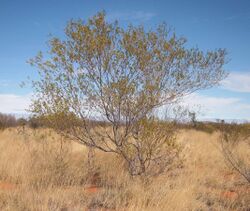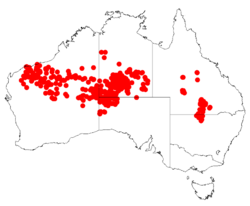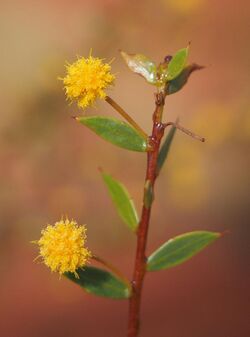Biology:Acacia maitlandii
| Maitland's wattle | |
|---|---|

| |
| Scientific classification | |
| Kingdom: | Plantae |
| Clade: | Tracheophytes |
| Clade: | Angiosperms |
| Clade: | Eudicots |
| Clade: | Rosids |
| Order: | Fabales |
| Family: | Fabaceae |
| Subfamily: | Caesalpinioideae |
| Clade: | Mimosoid clade |
| Genus: | Acacia |
| Species: | A. maitlandii
|
| Binomial name | |
| Acacia maitlandii | |

| |
| Occurrence data from AVH | |
| Synonyms[1] | |
|
Acacia maitlandi F.Muell. ex Benth. | |
Acacia maitlandii, also known as Maitland's wattle, is a perennial tree native to Australia .
Description
The shrub has an open and spindly habit, with a height of 0.7 to 3.0 metres (2 to 10 ft).[2] The resinous and glabrous branchlets are generally terete in form. The glabrous phyllodes are straight with a narrowly elliptic shape and are 0.8 to 2.5 centimetres (0.31 to 0.98 in) in length and 1 to 3 millimetres (0.039 to 0.118 in) wide.[3] Flowers are yellow and occur sometime between May and October.[2] The simple inflorescences occur singly in the axil of the phyllodes. The globose flower heads with a diameter of 4 to 5 mm (0.157 to 0.197 in) and contain 35 to 60 bright yellow flowers. Following flowering smooth papery seed pods form. The pods are straight and slightly constricted between seeds with a length of 4 to 5 cm (1.57 to 1.97 in) and 3 to 4 mm (0.118 to 0.157 in) wide.[3]
Taxonomy
The species was first described by Ferdinand von Mueller in 1862 as part of the work Fragmenta Phytographiae Australiae.[4] The plant is named for an early European explorer of Australia's Northwest, Maitland Brown, who collected the type specimen.[3] It was later reclassified as Racosperma maitlandii by Leslie Pedley in 1986 but transferred back into the genus Acacia in 2001.[5]
Distribution
Acacia maitlandii is found in all mainland states of Australia, except Victoria,[3] and is not considered to be threatened with extinction.[2] The favoured soil type is red sand, or stony ground; the habitat is sandy or stony plains, and on hills.[2]
Uses
The species is used to make boomerangs and spearthrowers, and the gum produced is edible. The tree is called Garrga in the languages of the Yindjibarndi and Ngarluma people.[6] The seeds have been identified, analysed, and monitored, as a 'wild harvested Australian indigenous food', by Food Standards Australia New Zealand. The product is found to very high in fats, over half by weight.[7]
See also
References
- ↑ "Acacia maitlandii F.Muell. ( as `Maitlandi' )". Australian Plant Name Index (APNI), IBIS database. Centre for Plant Biodiversity Research, Australian Government. http://www.anbg.gov.au/cgi-bin/apni?taxon_id=12041.
- ↑ 2.0 2.1 2.2 2.3 "Acacia maitlandii F.Muell.". FloraBase. Western Australian Government Department of Parks and Wildlife. https://florabase.dpaw.wa.gov.au/browse/profile/3434.
- ↑ 3.0 3.1 3.2 3.3 P.G. Kodela (2002). "Acacia maitlandii F.Muell.". New South Wales flora online. National Herbarium of New South Wales. http://plantnet.rbgsyd.nsw.gov.au/cgi-bin/NSWfl.pl?page=nswfl&lvl=sp&name=Acacia~maitlandii. "...named after Maitland Brown"
- ↑ Mueller, F.J.H. von (1863), Fragmenta Phytographiae Australiae 3(22): 46 Type: "In planitiebus lapidosis ad montes Hammersly Range legit Maitl. Brown sub expeditione Francisci Gregorii."(APNI)
- ↑ "Acacia maitlandii F.Muell. Maitland's Wattle". World Wide Wattle. Global Biodiversity Information Facility. https://bie.ala.org.au/species/http://id.biodiversity.org.au/node/apni/2888745#names.
- ↑ Burndud (1990). Wanggalili; Yinjibarndi and Ngarluma Plants. Juluwarlu Aboriginal Corporation. p. 17.
- ↑ "Acacia Maitlandii, Seed". NUTTAB 2006 Online Version. Food Standards Australia New Zealand. 2007-04-26. http://www.foodstandards.gov.au/monitoringandsurveillance/nuttab2006/onlineversionintroduction/onlineversion.cfm?&action=getFood&foodID=15A10016. "Food ID: 15A10116"
External links
Wikidata ☰ Q4670961 entry
 |


